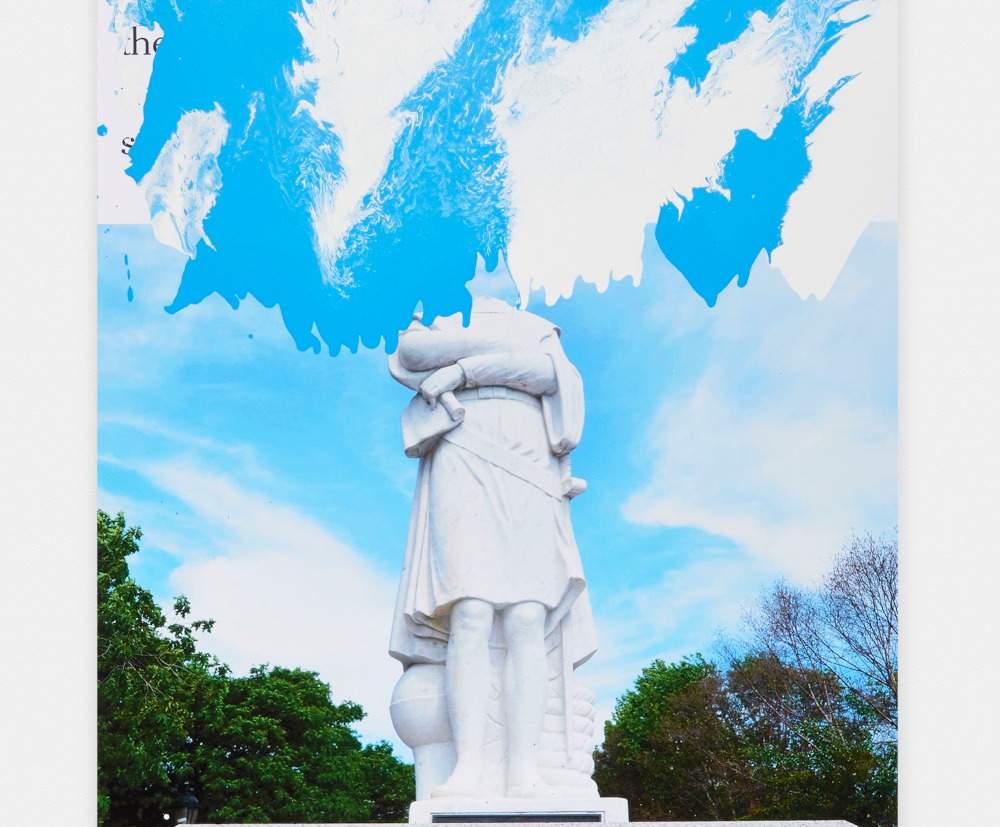Marc Quinn returns to Venice with new works born from screenshots and iPhone posts
Marc Quinn’s exhibition entitled Historynow, curated by Francesca Pini and Aindrea Emelife, a new chapter in his 10-year History Paintings project, will be on view at the National Archaeological Museum in Venice from April 21 to October 23, 2022. Forty-eight new paintings and one sculpture, Stele, will be on display in dialogue with the museum’s collection of classical antiquities.
The artist’s works originate as iPhone screenshots and replicate the digital portals through which humans absorb, consume and share news. Through the screens, society witnesses world-changing cultural events: accidents, human tragedies and natural disasters, interspersed with moments of pop cultural levity in an incessant stream of content.
Historynow intends to reproduce a scrolling journey through digital feeds, whose content oscillates between celebrity news and current events, global in scope. Unveiled in a space usually reserved for reflections on the past, connections are uncovered between Quinn’s new series and the museum’s classic sculptures. The artist thus returns to themes addressed throughout his career, posing questions concerning major social issues and the human condition.
The paintings dialogue in each room with the classical collection in the Archaeological Museum. Historical but highly topical themes such as ideals of beauty, power, war, and acts of heroism are explored. The last room of the exhibition then hosts a multimedia experience intended to provide additional context to the series of paintings, including interviews with people related to their imagery or content of the paintings. Through these paintings and interviews, Quinn wants to reflect on the viral and often incomplete stories to bring the audience back to the heart of the topic.
The paintings were made during lockdowns in the British government. While the technique, materials and results of the artist’s painting process vary, the screenshot as an underlying element remains a constant, evoking the ubiquity and urgency of news and technology in our lives.
Historynow, in conjunction with the 59.International Art Exhibition of the Venice Biennale, is an occasion to celebrate the reopening of the historic entrance to the Archaeological Museum from Piazzetta San Marco, after more than two decades of being closed to the public. The event of its reopening is marked by the display of a large sculpture by Marc Quinn among ancient Roman sarcophagi, elegant cylindrical altars of Greek origin, and the imposing statue of Marcus Vipsanius Agrippa sent from Rome for the Grimani of Santa Maria Formosa.
With the reopening of the courtyard, a single ticket will allow visitors to access the Procuratie Nuove complex from the Doge’s Palace without having to cross St. Mark’s Square.
“The creation of the Historynow series was both a meditative and cathartic interaction with the turbulent world in which we now live,” said Marc Quinn. “Digging into the liminal we all inhabit, between the viscerally real and the virtual abstract that is becoming the current state of existence. Showing the works in the National Archaeological Museum, I’m reminded that as new as our problems seem, many are manifestations of problems that humans have faced since the beginnings of art and indeed since the beginnings of human interaction. I couldn’t think of a better place to show them in Venice than at the National Archaeological Museum.”
Marcella De Paoli of the National Archaeological Museum in Venice, said, “This exhibition offers images of the ancient world, materialized by the marbles of the Archaeological Museum, alongside images of contemporary digital communication captured by Marc Quinn’s paintings. Their juxtaposition, then, suggests not only similarities but also antitheses. The images of the ancient world emerge from a slow process of selection, involving different actors over time, while those that appear on the screens of our devices are instantaneous. The former were meant to last over time, while the latter are ephemeral, not because they do not become entangled in the network, but because they are many and fleeting. The large number of images, which overwhelms each of us every day, makes them so: we manifest them with a gesture and then immediately let them go. Finally, images in the ancient world were mostly made for collective perception in public spaces, born out of shared values that made them meaningful. Those of the contemporary world are enjoyed individually in the closed sphere of the screen of mobile devices and are made viral by the many shares that, perhaps, recognize their meaning. What seems to be lacking today is the ability to mediate and filter.”
Image: Marc Quinn, Christopher Columbus. Historynow, detail (The New York Times)
 |
| Marc Quinn returns to Venice with new works born from screenshots and iPhone posts |
Warning: the translation into English of the original Italian article was created using automatic tools. We undertake to review all articles, but we do not guarantee the total absence of inaccuracies in the translation due to the program. You can find the original by clicking on the ITA button. If you find any mistake,please contact us.




























